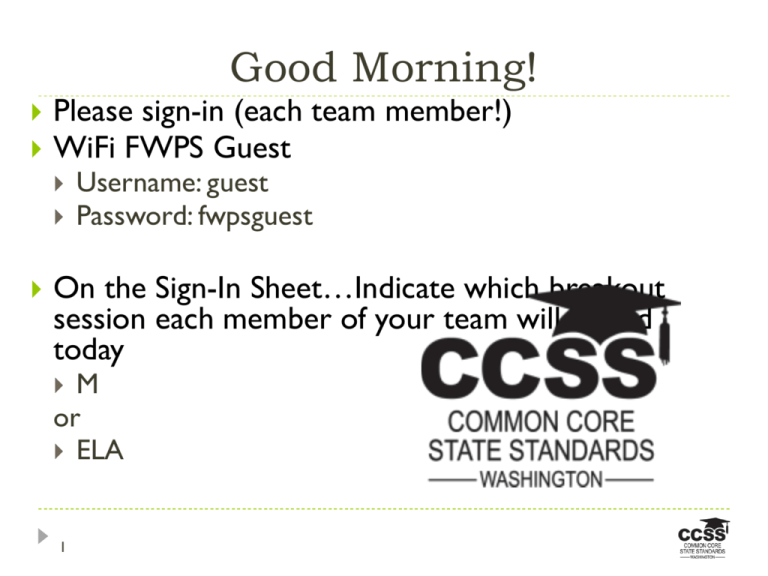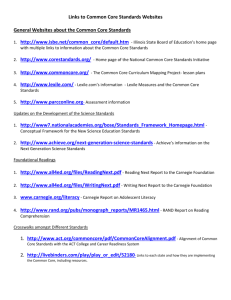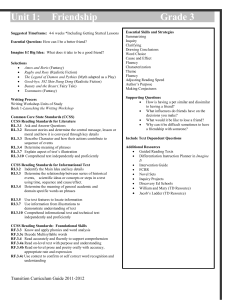Presentation - Office of Superintendent of Public Instruction
advertisement

Good Morning! Please sign-in (each team member!) WiFi FWPS Guest Username: guest Password: fwpsguest On the Sign-In Sheet…Indicate which breakout session each member of your team will attend today M or ELA 1 Welcome Back to Day 2! Please sign in! Our Focus and Learning Targets Participants will… Use results of the CCSS implementation Readiness Assessment to create (or build on) their CCSS Implementation plan for 2012-13 and beyond. Sharpen understanding and apply learnings about professional learning systems. Connect CCSS Implementation with other district initiatives, especially Teacher and Principal Evaluation. Consider their role to share with colleagues in their region and learn about opportunities for continued connections for supporting each other and other districts in their regions. 1. 2. 3. 4. AGENDA REVIEW 3 5/29/12 Welcome Back! Reflection on Day 1 to Inform Day 2 At your tables: Reflect on the notes you took during the Case Study/Problem of Practice Session yesterday Gather a pile of post-it notes and capture your thoughts from yesterday What did I hear/learn that might inform my district’s CCSS implementation plan? (1 idea per sticky) 4 Share all of your post-its with your team Sort to determine categories Discuss the category with the most comments and discuss how this will impact your plan 5/29/12 Revisiting the CCSS and Digging into Resources Math and ELA Breakout Sessions (8:45 – 10) 10:00 BREAK 10:15 Reconvene with your Teams 5 WA CCSS Implementation -WaCTE Summer Conference, 8-6-12 TEAM TIME: Linking the Resources to your Plans How do the resources for both ELA and Math fit into your district plan? What resources will best serve which audiences? What other resources did you find that you need to support varied audiences? What do you need to consider in light of the instructional shifts and resources available? 6 5/29/12 Large Group Reflection How confident do you feel in your team’s ability to reach your 30 day goals given your plan? Rank your readiness…TEXT VOTING 7 5/29/12 Large Group Reflection Connecting CCSS to Other Initiatives Making connections: How do CCSS and Educator Evaluation Systems work together? 9 5/29/12 Making Connections: How do CCSS and TPEP work together? August 9, 2012 CCSS through the TPEP Lens or Vice Versa •Pilots •RIGs •Those just starting the journey Essential Questions • How does the language of the frameworks connect with the Common Core State Standards? • How do you help make sense of two “really big deals”? • How do plan for the managed implementation of both? Racing up the Mountain… A View from the Top! Background Teacher and Principal Evaluation Project (TPEP) Anacortes Central Valley Kennewick North Thurston North Mason Othello Snohomish Wenatchee 15 TPEP Pilots 12 SIG Districts 71 RIG I ESD 101 Consortium 98 RIG II Almira Open a RIG III in Fall Davenport Liberty Medical Lake Pullman Reardan-Edwall Wellpinit Wilbur Criteria 1 Criteria 2 Criteria 3 Criteria 4 Criteria 5 Criteria 6 Frameworks + Student Growth Rubrics Observation Artifacts Other evidence relevant to the frameworks District determined process State determined process Distinguished Proficient Basic Unsatisfactory Distinguished Proficient Basic Unsatisfactory Criteria 7 Student Growth Measures Student Growth Impact Ratings: Criteria 8 (From 3 specific criteria) Low, Average, High Teachers: Principals: “fostering and managing a safe, positive learning environment.” “creating a school culture that promotes the ongoing improvement of learning and teaching for students and staff.” “collaborative and collegial practices focused on improving instructional practice and student learning.” “providing for school safety.” Teachers: “using multiple student data elements to modify instruction and improve student learning.” Principals: “development, implementation, and evaluation of a data-driven plan for increasing student achievement, including the use of multiple student data elements.” Teachers: Principals: “providing clear and intentional focus on subject matter content and curriculum.” “assisting instructional staff with alignment of curriculum, instruction, and assessment with state and local district learning goals.” Teachers: Principals: Implementing the instructional framework “monitoring, assisting, and evaluating effective instruction and assessment practices.” Teachers: Principals: “communicating and collaborating with parents and school community.” “partnering with the school community to promote learning.” Table Talk Where do you already see and want to make the connection between the criteria and CCSS? Essential Questions • How does the language of the frameworks connect with the Common Core State Standards? • How do you help make sense of two “really big deals”? • How do you plan for the managed implementation of both? Note: The component numbers for both Danielson and CEL are reflective of the component numbers in their original frameworks, thus they may not be in numerical order Framework Danielson Framework for Teaching CEL 5D+TM Teacher Evaluation Rubric 2.0 Marzano Art and Science of Teaching Framework Dimensions Domains Domain or Dimension Domain 1: Planning and Preparation Domain 2: The Classroom Environment Domain 3: Instruction Domain 4: Professional Responsibilities Domains Purpose Student Engagement Curriculum and Pedagogy Assessment for Student Learning Classroom Environment and Culture Professional Collaboration and Communication Domain 1: Classroom Strategies and Behaviors Domain 2: Planning and Preparing Domain 3: Reflecting on Teaching Domain 4: Collegiality and Professionalism Components Components – 22 Sub-dimensions – 13 Evaluation Level Rubric (Example: Component 1b: Demonstrating Knowledge of Students) (Example: Student Engagement 5: (Example: 3.1 The teacher knows Use of Background to plan individual student learning needs lessons and units) to design instruction) Indicators Indicators (4 level) Components– 31 Possible Teacher Evidence Possible Student Evidence Support for observation Critical Attributes/Possible Examples – teacher and student Possible Teacher Observables Possible Student Observables Possible Artifacts Possible Impacts Criterion 1: Centering instruction on high expectations for student achievement Key Word: EXPECTATIONS Definition: The teacher develops and communicates high expectations for student learning. Danielson CEL 5D+ Marzano Purpose Domain 2: The Classroom Environment P1: Connection to standards, broader purpose and transferable skill P4: Communication of learning target(s) 2b: Establishing a Culture for Learning P5: Success criteria and performance task(s) Component 1.1: Providing Clear Learning Goals and Scales (Rubrics) Component 1.2: Celebrating Success Component 1.3: Understanding Students’ Interests and Backgrounds Domain 3: Instruction Student Engagement 3a: Communicating with Students SE3: Work of high cognitive demand Component 1.4: Demonstrating Value and Respect for Low Classroom Environment & Expectancy Students Culture 3c: Engaging Students in Learning CEC3: Discussion, collaboration and accountability Exploration Time • Using documents regarding Criterion 1 (teacher) or Criterion 4 (principal), – review the indicators, rubric language and observables/evidence – discuss (highlight if you wish)what connections you see with CCSS – discuss how you will plan for keeping these connections clear to others Implications for CCSS/TPEP Implementation • Classroom Teachers • Building Administrator • District Office TPEP Webinars Webinar #1 • Evaluation System Orientation - Instructional and Leadership Frameworks • Student Growth - Summative Methodology • Thursday, August 23 from 1:30-3:30pm Webinar #2 • Evaluation System Orientation - Instructional and Leadership Frameworks • Student Growth - Summative Methodology More information will be posted on OSPI website. • Thursday, August 30 from 1:30-3:30pm 29 TEAM TIME: Bringing it Home: Making Connections in your CCSS Plans Where does TPEP implementation fit within your CCSS plan and next steps? What are key actions you need to take to integrate it into your plan? What opportunities are present to support this? Who are key champions to support this effort? 30 5/29/12 Next Steps – How to stay connected 31 5/29/12 Staying connected as a professional learning SYSTEM around the CCSS… What opportunities exist at your local level? Within your district? With districts nearby? What opportunities exist at your regional, ESD, levels? District teaching and learning leader collaboratives (assistant superintendents) Content-specific “cadres” 32 5/29/12 Staying connected as a professional learning SYSTEM around the CCSS… OSPI Webinar Series, 2012-13; Statewide presentations CCSS System Thinking for District/Building Leaders CCSS Mathematics CCSS English Language Arts September 12, 2012 10:30–11:30 a.m. September 18, 2012 3:30–4:30 p.m. September 20, 2012 3:30–4:30 p.m. December 12, 2012 10:30–11:30 a.m. December 18, 2012 3:30–4:30 p.m. December 20, 2012 3:30–4:30 p.m. March 7, 2013 10:30–11:30 a.m. March 12, 2013 3:30–4:30 p.m. March 14, 2013 3:30–4:30 p.m. May 23, 2013 10:30–11:30 a.m. May 28, 2013 3:30–4:30 p.m. May 30, 2013 3:30–4:30 p.m. Learning Forward Washington connections Follow on Twitter (@lrngforwardWA and #CCSSLFWA) LF WA Blog Become a member 33 5/29/12 Staying connected as a professional learning SYSTEM around the CCSS… What are ways that you can commit to keeping the momentum within your team and with districts around you? 34 5/29/12 And now…Onto 2012-13! Ways to stay connected: CCSS OSPI Web Site: http://www.k12.wa.us/Corestandards/default.aspx OSPI Teaching and Learning Monthly Newsletter 35 TEACH: http://www.k12.wa.us/CurriculumInstruct/news.aspx WA CCSS Implementation -WaCTE Summer Conference, 8-6-12 36 5/29/12






